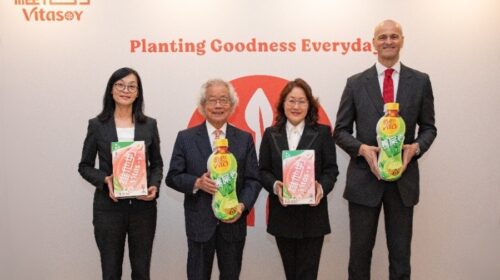Jiaxin mines Hong Kong, Kazakhstan for IPO funds

The tungsten miner expects to launch commercial operations at its Boguty open-pit project in Kazakhstan in the first quarter of 2025
Key Takeaways:
- Jiaxin International has applied to make dual listings in Hong Kong and Kazakhstan, where it is also preparing to launch commercial operation of its Boguty tungsten mine
- The company looks like a strong public-private partnership between an entrepreneur with an investment background and state-run mining giant Jiangxi Copper
By Doug Young
As 2025 kicks off, we’ve been prospecting for hidden gems to bring you from the small flood of year-end IPO applications, mostly in Hong Kong but also a few in the U.S. Among those, a Hong Kong listing application from tungsten miner Jiaxin International Resources Investment Ltd. stands out not only for its relatively unusual business, but also for where the company plans to sell its shares.
In addition to offering 125 million ordinary shares to investors in Hong Kong, Jiaxin also plans a smaller float of 1.3 million shares on the stock exchange in the Central Asian nation of Kazakhstan, according to a notice on the Chinese securities regulator’s website last month. Jiaxin made its first and only public filing to the Hong Kong Stock Exchange last August, but the CSRC notice means the plan can now move ahead.
The company’s plan centers on a single project, the Boguty tungsten mine in Kazakhstan, which shares a border with China. It looks like a relatively strong public-private partnership between an entrepreneur named Liu Liqiang, who comes from an investment background, and Jiangxi Copper (0358.HK; 600362.SH), a state behemoth that is China’s largest copper producer. Both Liu, as Jiaxin’s chairman, and Jiangxi Copper are jointly running the show, with each holding more than 40% of the company’s shares.
Many of Jiaxin’s senior executives also come from Jiangxi Copper, including its CEO Wang Zhongwei and CFO Liu Peng. While the mine only began limited production at the end of 2024, its mix of public and private sector elements should give it strong chances for success.
Jiangxi Copper has huge resources to offer, including money to keep Jiaxin going while it scales up the operation. Any needed new financing should be especially easy to attract since the mine appears to be classified as a project under China’s Belt and Road Initiative, which, as a pet project of Beijing, has easy access to all kinds of money.
Liu’s more entrepreneurial background should also help to keep Jiaxin from becoming too mired in bureaucracy, which is always a potential vulnerability for big state-run enterprises. His CFO Liu Peng also looks quite adept at managing the company’s debt, which probably owes to his connections and experience with Jiangxi Copper.
One of the biggest risks to this project comes from its location in Kazakhstan, which was a site of major political unrest in January 2022. We’ll return to that later, but suffice it to say that such unrest could theoretically return at any time.
Leading Chinese investment bank CICC is the listing’s lone underwriter, meaning it’s likely to be a mid-size offering raising between $50 million and $100 million. The new mine will further add to China’s status as the world’s leading producer of tungsten, which is used in electrodes and heating elements, and is known to many for its use in light bulb filaments.
Soviet roots
The Boguty project’s roots are quite old, dating back to when Kazakhstan was still part of the Soviet Union. Its huge tungsten deposits were first discovered in 1941, and rights to develop the resource were initially purchased by a state-owned Kazakh company in 2014. Jiaxin’s involvement dates back to that time, with the company acquiring the project in 2016.
The project is relatively well located, about 180 km to the east of Kazakh capital Almaty and 160 km west of the Korgos border crossing between China and Kazakhstan. It’s also just 20 km from a rail line between Almaty and the Korgos crossing, meaning relatively little additional transport infrastructure will be required to ship the ore to either China or Almaty for processing.
Jiaxin also points out the project has access to adequate water and electricity supply, again reducing the need for additional spending on this kind of supporting infrastructure.
As to the project itself, Jiaxin calls it the world’s largest open pit tungsten mine, and the world’s fourth largest among all tungsten mines. It has 70.8 million tons of probable tungsten ore reserves, at a relatively high average grade of 0.205%. Jiaxin will process most of the ore itself, first into ammonium paratungstate (APT), an intermediate compound used to make the final tungsten products.
The mine began trial production in the fourth quarter of 2024, producing around 600,000 tons of ore. It expects to start commercial production in the first quarter of 2025, with a target of 3.3 million tons of ore for the year. That amount would gradually grow to nearly 5 million tons annually by 2027.
The latest tungsten ore price of around $333 per ton, combined with the 2025 production target of 3.3 million tons, would equal around $1 billion in revenue if the company were simply selling the ore. But the figure is likely to differ a bit, since plans don’t always go according to schedule, and Jiaxin also plans to process a lot of the ore itself, which requires more time and facilities and also carries higher prices.
Financially, the company’s losses have been growing steadily, hitting HK$65 million ($8.4 million) in the first half of last year. But its gearing ratio has been relatively steady, ranging between 89% and 94% over the last two years, even as its outstanding debt jumped from HK$557 million at the end of 2022 to HK$1.6 billion last year. Those figures seem relatively normal for a company developing this kind of new project, and also show it seems to have its debt under control.
We’ll end with a quick look at the 2022 unrest in Kazakhstan, which appears to have erupted spontaneously over rising fuel prices and broader discontent about the country’s autocratic government. The unrest grew violent, leaving more than 200 dead, but was eventually put down after military assistance arrived from Russia. The government has made some reforms since then, though it’s always possible unrest could break out again.
At the end of the day, this IPO looks relatively interesting for its public-private ownership, and the strong potential for the mine it plans to develop. Commodity prices are notoriously fickle, which will always be a risk for this kind of mining company. And politics are always another risk factor, not only due to the potential for unrest, but also due to the weak legal protections in autocratic countries like Kazakhstan.
To subscribe to Bamboo Works weekly free newsletter, click here






